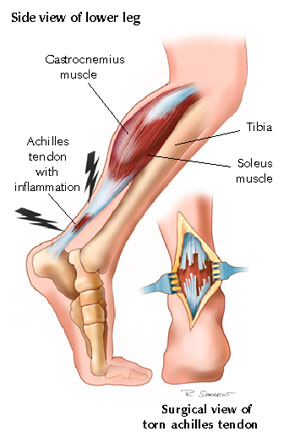Achilles Tendon Injury - pain, rupture, treatment, repair and surgery

What is Achilles Tendon Injury
Achilles tendon injury is Traumatic damage to the ACHILLES TENDON, the broad band of connective tissue that joins the calf muscles to the heel of the foot. The most common Achilles TENDON injury is INFLAMMATION, called Achilles TENDONITIS, tends to develop somewhat gradually as an overuse injury. A tear in the Achilles tendon, called a rupture, generally happens suddenly during an athletic activity or event. Extended running, especially uphill or in shoes with flat heels (such as racing flats), and jumping are activities that place the Achilles tendon at risk for injury.
Symptoms of Achilles Tendon Injury and Pain
Achilles tendonitis causes PAIN and tenderness to touch at the base of the calf muscles on the back of the leg. The inflamed area may appear swollen. Though the pain may restrict the ability to use the foot and ankle, the mechanical functions of the Achilles tendon remain intact, and the person can perform the movements necessary to walk. Achilles tendonitis may follow a competitive event that places high stress on the legs, such as a race, or may develop during a new training regimen.
Achilles Tendon Rupture
An Achilles rupture occurs suddenly during movement that stresses the Achilles tendon, such as running. The Achilles tendon is especially vulnerable to quick movements that place extreme stress on it, such as a “plant and twist” maneuver in sports such as tennis, soccer, basketball, soccer, and football. Runners may tear the Achilles tendon when starting from blocks or when accelerating for the finish. The injury causes a popping sensation, followed by pain and an inability to move the ankle and foot very well. When the tear is complete, severing the Achilles tendon, the person cannot point the foot downward to perform the basic movements of walking. Pain is most often at the back of the heel.
The ability to move the foot is generally the distinguishing factor between Achilles tendonitis and Achilles tendon rupture. The doctor’s examination includes testing the Achilles tendon reflex, probing for areas of sensitivity (palpable divot), and watching the person move the feet with the legs dangling (seated on an examination table) and when walking. Diagnostic imaging procedures such as MAGNETIC RESONANCE IMAGING (MRI) and ULTRASOUND can confirm the diagnosis though usually are not necessary unless the doctor suspects a complete rupture and needs to assess the extent and location of damage before surgery to repair it.
Achilles Tendon Injury Treatment, Repair and Surgery
Most Achilles tendon injuries heal with ice, rest, and NONSTEROIDAL ANTI-INFLAMMATORY DRUGS (NSAIDS) to reduce inflammation and pain. The doctor may choose to cast the lower leg and foot to immobilize the ankle when the injury is severe. Surgery is usually necessary to repair significant or total Achilles tendon rupture. HEALING is complete when the person can move the injured foot with the same ease and range of motion as the uninjured foot, which may take six weeks to three months for repair and six months for rehabilitation, depending on the injury’s severity. Swimming is an excellent activity for rehabilitation, as it allows full range of motion and use of the Achilles tendon without impact.
Stretching and WARM-UP before athletic activities, including WALKING FOR FITNESS, are the most effective methods for reducing the risk of injury to the Achilles tendon. People who have tight calf muscles or previous Achilles tendon injury benefit from regular stretching (once or twice daily) regardless of athletic activity.
See also ANKLE INJURIES; ATHLETIC INJURIES; BONE SPUR; SPRAINS AND STRAINS.
Open discussion on the topic Achilles Tendon Injury - pain, rupture, treatment, repair and surgery
Similar interests
- Nuovi Casino
- Casinos Not On Gamstop
- UK Casinos Not On Gamstop
- Casinos Not On Gamstop
- UK Casinos Not On Gamstop
- Casino Non Aams Italia
- Slot Sites Not On Gamstop
- Meilleur Casino En Ligne
- Non Gamstop Casino Sites UK
- Meilleur Casino En Ligne
- Casino En Ligne France
- Best Non Gamstop Casinos
- Casinos Not On Gamstop
- UK Casino Not On Gamstop
- Casinos Not Signed Up To Gamstop
- Best Slot Sites UK
- Non Gamstop Casino Sites UK
- Online Casinos Nederland
- Online Casinos Nederland
- Casinos Not On Gamstop
- Best New Uk Casinos Not On Gamstop
- Casino Non Aams
- Non Gamstop Casinos UK
- Migliori Siti Casino Non Aams
- Bitcoin Casinos